|
MobileDemand xTablet T1600
Elegant, thin and light, yet rugged Intel "Haswell" powered 11.6-inch Windows tablet for on-the-go professionals
by Conrad H. Blickenstorfer
When MobileDemand introduced their rugged "thin-and-light" xTablet T1600 with its large 11.6-inch display late last year, the company instantly enhanced their reach into the market of on-the-go professionals. These are people in field service, field sales, retail, healthcare, warehousing and the public sector who need top performance in a ruggedized tablet form factor. In this article we're taking a detailed look at MobileDemand's popular big screen tablet.

One of the inherent problems in the tablet market is differentiation. Consumer tablet leaders Apple and Samsung have pretty much set customer expectations as to what a tablet should look like. By and large, any deviation from that ideal is punished by criticism or lack of interest. For manufacturers of rugged tablets, that is a particularly difficult challenge: their products must be tough and rugged and trendy and appealing enough to be accepted by a customer base that is all too tempted to simply buy inexpensive consumer tablets and stick them in a case.
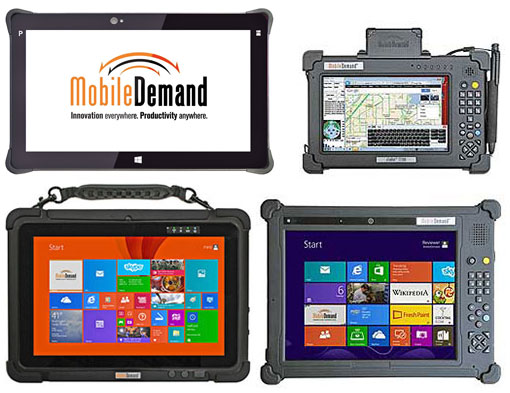 Where does the new xTablet T1600 fit in? In essence, it provides a larger screen "power user" alternative to MobileDemand's existing tablets, those being the affordable 8-inch xTablet Flex 8 and 10.1-inch xTablet Flex 10 for customers considering consumer tablets but really need extra protection; the thin-and-light 10.1-inch T1400 (lower left) for those who need sealing, faster performance, barcode reading, and fast access to large local data; and the ultra-rugged 7-inch xTablet T7200 (upper right) and 10.4-inch xTablet T1200 (lower right) for the military or use in ultra-rugged or hazardous environments. Where does the new xTablet T1600 fit in? In essence, it provides a larger screen "power user" alternative to MobileDemand's existing tablets, those being the affordable 8-inch xTablet Flex 8 and 10.1-inch xTablet Flex 10 for customers considering consumer tablets but really need extra protection; the thin-and-light 10.1-inch T1400 (lower left) for those who need sealing, faster performance, barcode reading, and fast access to large local data; and the ultra-rugged 7-inch xTablet T7200 (upper right) and 10.4-inch xTablet T1200 (lower right) for the military or use in ultra-rugged or hazardous environments.
The T1600 clearly represents a new breed of tablet, one that is fashionably thin and light, uses the popular capacitive multi-touch, offers adequate onboard I/O, yet is much tougher and far better suited for business and the field than all those slender, fragile consumer tablets. Such a tablet must combine a modern look and feel with state-of-the-art Intel Core processor performance, the full Microsoft Windows experience, and enough customization potential to suit virtually any job. How did the designers of the T1600 go about that?
In terms of overall design, the tablet looks as sleek and hi-tech as the latest consumer products, but with clear design cues that broadcast extra toughness, and also provide a much more solid feel. So there's the basic contemporary tablet design with a black bezel and glass covering the entire surface. But there are also four subtle but still prominent corner rubber guards for protection.
What about the display? While all desktop and laptop screens are landscape-oriented, the very concept of a tablet stems from the ubiquitous 8-1/2 x 11 portrait-oriented pad of paper. Apple cemented that concept with the iPad, and Android followed suit. Windows, however, remains very much a landscape-oriented OS, and most corporate customers still use Windows on tablets and are therefore best served with a wide-format display large enough for work as opposed to consumption. So the T1600's screen measures 11.6-inches diagonal and has a wide 16:9 aspect ratio. That's noticeably larger than the 10-inch iPad class.
While the T1600 looks very much like a consumer tablet, it is considerably tougher and has the ports a full Windows tablet needs. As a result it is 0.8 inches thick and weighs about 2.8 pounds, significantly more than a consumer tablet, but remarkably thin and light for a professional tool for the job.
Since consumer tablets firmly established capacitive multi-touch with its effortless tapping, pinching and zooming as the technology of choice, the T1600 had to have it, too. But while Windows 10 is nicely touch-optimized, the still widely used earlier versions of Windows have plenty of tiny check boxes, scrollers, and controls, and so MobileDemand also offers an optional digitizer with an active pen.
Just to present an overall idea of what MobileDemand offers, the table below shows pertinent specs of MobileDemand's T-Series of rugged tablets, each of which emphasizes a different aspect of the tablet form factor:
|
|
MobileDemand
|
MobileDemand
|
MobileDemand
|
MobileDemand
|
|
Model
|
xTablet T1600
|
xTablet T1400
|
xTablet T1200
|
xTablet T7200
|
|
|
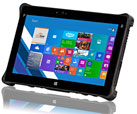
|

|
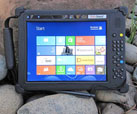
|
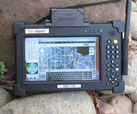
|
|
OS in test machine
|
Win 8.1 (64-bit)
|
Win 8.1 (64-bit)
|
Win 8 (64-bit)
|
Win 7 (32-bit)
|
|
Processor Type
|
Intel Core
|
Intel Celeron
|
Intel Core
|
Intel Atom
|
|
Processor Model
|
i5-4200U
|
N2920
|
i5-3427UE
|
N2600
|
|
Cores/threads
|
2/4
|
4/4
|
2/4
|
2/4
|
|
CPU Speed
|
1.60GHz
|
1.86GHz
|
1.80GHz
|
1.60GHz
|
|
Max Turbo Speed
|
2.60GHz
|
2.00GHz
|
2.70GHz
|
no turbo
|
|
Thermal Design Power (TDP)
|
15 watts
|
4.5 watts
|
17 watts
|
3.5 watts
|
|
Size (inches)
|
11.8 x 7.6 x 0.78
|
10.8 x 7.8 x 0.7
|
11.2 x 8.6 x 1.6
|
10.6 x 7.2 x 1.65
|
|
Volume (cu inches)
|
70
|
58
|
154
|
78
|
|
Weight (pounds)
|
2.7
|
2.4
|
4.8
|
3.3
|
|
Display size
|
11.6" (10.11 x 5.69)
|
10.1" (8.56 x 5.35)
|
10.4" (8.32 x 6.24)
|
7.0" (6.04 x 3.54)
|
|
Display res/dpi
|
1366 x 768 pixel, 135 dpi
|
1920 x 1200 pixel, 223 dpi
|
1024 x 768 pixel, 123 dpi
|
1024 x 600 pixel, 169 dpi
|
|
Display aspect ratio
|
16 : 9
|
16 : 10
|
4 : 3
|
17 : 10
|
|
Display area
|
57.0 in2
|
45.8 in2
|
51.9 in2
|
22.0 in2
|
|
Digitizer
|
procap multi
|
procap multi
|
resistive multi
|
resistive
|
|
Operating temp
|
14° to 131° F
|
-4° to 140° F
|
-4° to 140° F
|
-4° to 140° F
|
|
Battery/Battery Life
|
46 watt-hour ("7 hrs")
|
78 watt-hour ("12 hrs")
|
58 watt-hour ("up to 10 hrs")
|
37 watt-hour ("8-12 hrs")
|
Below is a look at the xTablet T1600 from the front and from all four sides. It's an elegant and attractive design with a hardened and well-protected glass front, a black plastic case, and organically integrated black rubber bumpers. The bezel space around the LCD part of the display is wide enough to hold the tablet without triggering a touch command, and except for the slightly protruding rubber bumpers there is no border for fingers to bump into while operating the tablet.
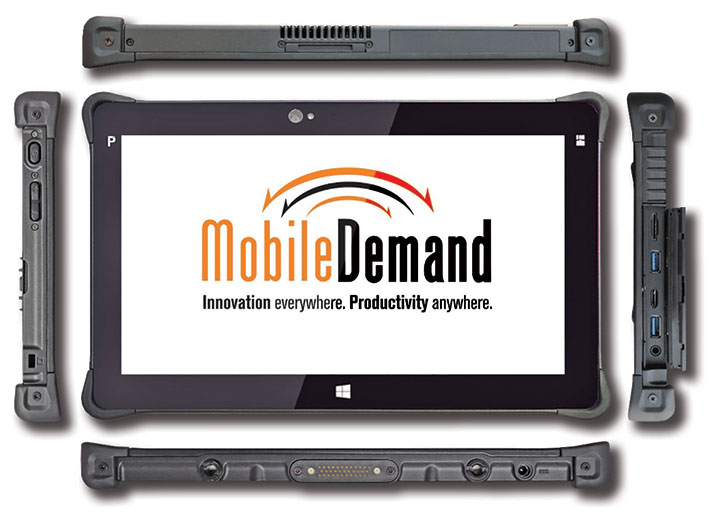
On top of the unit is the grill for a small fan. While we prefer fanless designs in the field, having Intel Core performance — and maintaining it when it gets hot — in such a light and slender unit does require active cooling. Note that the fan is waterproof and the fan compartment is sealed against the interior.
Along the left side are the power button, a small audio volume rocker, and a Kensington lock slot for physical security.
On the bottom is a surface-mount "Pogo" docking connector for use with one of the two available docks. It provides power pass-through, HDMI, serial, and USB 3.0, as well as RF pass throughs for WWAN and GPS. There is also the DC-in jack that we'd rather have seen located on the side, and two mounting/security screw holes.
Equipping a rugged tablet with onboard ports is a challenge because there isn't much space, and sealing requirements favor designs with as few openings to the inside as possible. A Windows-based enterprise tablet, however, needs at least a minimal degree of onboard connectivity, and below you can see what the T1600 offers. There's more than most consumer tablets, but not as much as a notebook or thicker tablets:

Almost all I/O is concentrated in a recessed area on the right side of the tablet. You get two full-size USB 3.0 ports, an SD/SDHC/SDXC card slot and a SIM card slot, and an audio jack.
There are undoubtedly those who would have liked to have an RJ45 LAN jack, HDMI, or perhaps a legacy serial port onboard the tablet, but this is one of the compromises MobileDemand had to make. There is an expansion connector that provides power pass-through, dual USB 2.0 and RS232, and can be used for certain options, including a mag stripe reader. In addition, there's Intel WiDi (Wireless Display) for wireless connection to monitors, TVs and projectors equipped via a WiDi adapter.
A look inside
While the xTablet T1600's sleek and slender exterior design makes it look much like a slightly thicker consumer market tablet with added protective corner guards, inside it is all business. That begins with the Lithium-Ion battery that is recessed flush into the backside of the tablet so it can quickly and easily be replaced; the internal, non-replaceable batteries used in most consumer tablets would be unacceptable to most business users. A friction lever with a push button activator securely holds the battery in place, making it unlikely that it'll come loose accidentally.
Since there is not battery compartment cover, the battery contact area has a rubber seal that presses against the magnesium frame to make a watertight seal. Whenever replacing the battery, make sure the seal is fully intact. The slender (3/8-inch) battery itself is rated at 11.1 Volt, 4.1 Ahr, for a total of 45 watt-hours. If that's not enough, MobileDemand offers an optional high-capacity 78.4 watt-hour Li-Polymer battery.
Many mobile devices have individual access doors in the back to get to RAM, wireless and other areas. On the T1600, the entire backside comes off. It's a thin, tough plastic cover with an elaborate design that is secured with about 20 Philips screws of various sizes. Below you can see the xTablet T1600 with its bottom plate removed and sitting beside the tablet.
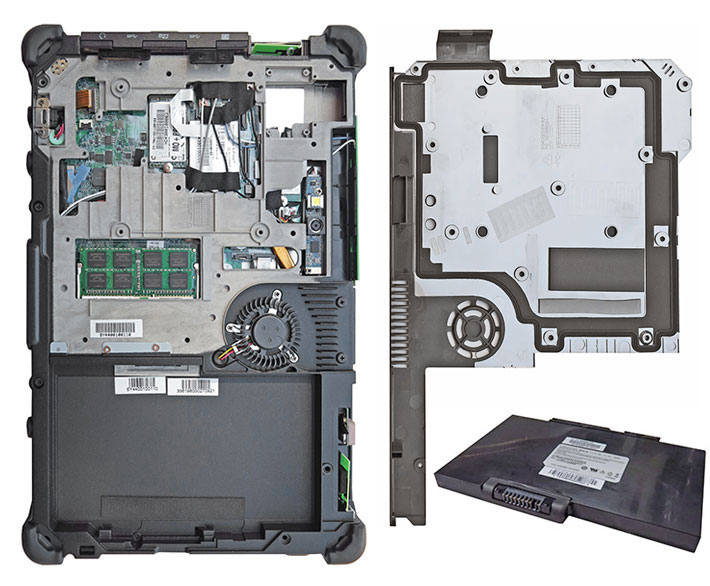
As can be seen, the tablet is built around a strong and very rigid magnesium chassis with cutouts for access to replaceable standard and optional modules.
Initially one might wonder how the thin plastic back cover with its various cutouts and openings is compatible with the claim of ruggedness and protection against the elements. That, in fact, is made possible via the back cover's multi-lipped rubber seal that presses against the magnesium internal frame of the tablet. This seals the tablet's interior electronics and keeps them from harm.
But what about the fan, heat exchanger, speaker, antennae, and a number of the attachment screws that are technically all on the outside of the tablet and thus may be subject to exposure to liquids?
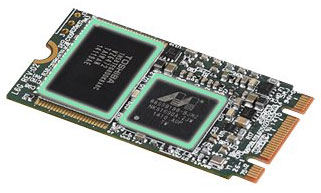 Well, whatever screws are located inside the sealed area of the tablet have small rubber o-rings on them to keep liquids out. The fan is not affected by water, and neither are any other elements that may come in contact with liquids.
This is a clever, intricate design that provides easy access and ease of servicing, customizing and reconfiguration. But it's also a design that does rely on meticulous attention to all the seals and o-rings any time the back cover is removed. Well, whatever screws are located inside the sealed area of the tablet have small rubber o-rings on them to keep liquids out. The fan is not affected by water, and neither are any other elements that may come in contact with liquids.
This is a clever, intricate design that provides easy access and ease of servicing, customizing and reconfiguration. But it's also a design that does rely on meticulous attention to all the seals and o-rings any time the back cover is removed.
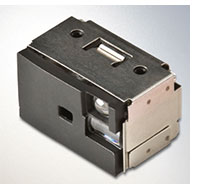 Our eval unit came with a Kingston SO-DIMM in the tablet's sole RAM slot, a Sierra Wireless AirPrime EM7355 Qualcomm 4G WWAN module, and a Lite On PLEXTOR PX64M6G SSD. Our eval unit came with a Kingston SO-DIMM in the tablet's sole RAM slot, a Sierra Wireless AirPrime EM7355 Qualcomm 4G WWAN module, and a Lite On PLEXTOR PX64M6G SSD.
There is also a small compartment that is reserved for an optional industrial-grade Honeywell Intermec EA31 2D CMOS imager module (see EA31 product page). MobileDemand emphasizes the performance, low power draw, and lack of laser issues of the EA31 for those who may be concerned about the use of lasers for scanning.
Below is a closer look at some details. On the left the small waterproof fan that removes heat from the processor and ancillary electronics, enabling the T1600 to perform at a high level even under extreme operating conditions. In the middle the very competent rear-facing camera module. And on the right the surface mount docking connector with all of its pass-throughs.

Impressive performance
Selecting the right processor for a tablet is never easy. The difference between a low-end CPU (such as found in most consumer tablets) and a high-end CPU (such as is required for demanding professional field applications) can be several hundred dollars for the chip alone. Then there are thermal, graphics, power usage and integrated special features considerations, and also how a product fits into the competitive landscape.
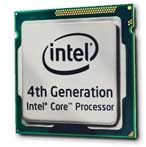 Just like rugged laptops, rugged Windows tablets come at various different levels of performance. Some are based on Atom processors, the latest generation of which — Bay Trail — are marketed not only under the Atom name, but also under the Celeron and Pentium brand names. The latter two, especially, offer much improved performance compared to earlier generations of Atom processors, but there remains a significant difference between Intel's Core and Atom offerings both in terms of performance and integrated features. Just like rugged laptops, rugged Windows tablets come at various different levels of performance. Some are based on Atom processors, the latest generation of which — Bay Trail — are marketed not only under the Atom name, but also under the Celeron and Pentium brand names. The latter two, especially, offer much improved performance compared to earlier generations of Atom processors, but there remains a significant difference between Intel's Core and Atom offerings both in terms of performance and integrated features.
The xTablet T1600 is for power users, and so MobileDemand chose the Core i5-4200U from Intel's lineup of "Haswell" 4th generation mobile Core processors. With Haswell, Intel made major steps forward in combining excellent performance with power savings and significantly improved onboard graphics. Running at a base frequency of 1.60GHz and a maximum turbo speed of 2.60GHz, the dual-core i5-4200U includes integrated Intel HD Graphics 4400 while operating at a low thermal design power of just 15 watts. Thermal Design Power is an Intel measure of the maximum processor heat a cooling system has to be able to remove, and also a rough measure of maximum performance.
To provide an idea of the kind of performance the xTablet T1600 offers compared to MobileDemand's other rugged tablets, we ran our standard benchmark suite, Passmark Software's PerformanceTest 6.1, that runs about 30 tests covering CPU, 2D graphics, 3D graphics, memory, and disk and then computes scores for each category and an overall PassMark score. We also ran our second benchmark suite, CrystalMark, for confirmation and additional information. For comparison we included benchmark results of MobileDemand's xTablet T1200, T1400 and T7200.
The results are as follows:
|
|
MobileDemand
|
MobileDemand
|
MobileDemand
|
MobileDemand
|
|
Model
|
xTablet T1600
|
xTablet T1400
|
xTablet T1200
|
xTablet T7200
|
|
|

|

|

|

|
|
Processor Type
|
Intel Core
|
Intel Celeron
|
Intel Core
|
Intel Atom
|
|
Processor Model
|
i5-4200U
|
N2920
|
i5-3427UE
|
N2600
|
|
CPU Speed
|
1.60GHz
|
1.86GHz
|
1.80GHz
|
1.60GHz
|
|
Max Turbo Speed
|
2.60GHz
|
2.00GHz
|
2.70GHz
|
no turbo
|
|
Thermal Design Power (TDP)
|
15 watts
|
4.5 watts
|
17 watts
|
3.5 watts
|
|
PassMark 6.1
|
xTablet T1600
|
xTablet T1400
|
xTablet T1200
|
xTablet T7200
|
|
CPU Mark
|
2,488.7
|
2,014.7
|
3,203.0
|
483.9
|
|
2D Graphics Mark
|
365.1
|
153.1
|
505.5
|
77.9
|
|
Memory Mark
|
830.6
|
409.9
|
1,181.1
|
224.7
|
|
Disk Mark
|
2,985.5
|
2,048.3
|
2,085.1
|
1,706.8
|
|
3D Graphics Mark
|
387.9
|
115.3
|
440.2
|
72.4
|
|
Overall PassMark
|
1,516.2
|
1,062.7
|
1,618.0
|
532.0
|
|
CrystalMark
|
xTablet T1600
|
xTablet T1400
|
xTablet T1200
|
xTablet T7200
|
|
ALU
|
37,045
|
26,714
|
41,048
|
10,680
|
|
FPU
|
36,633
|
22,451
|
39,149
|
7,997
|
|
MEM
|
28,295
|
16,411
|
43,919
|
6,991
|
|
HDD
|
35,336
|
36,655
|
33,392
|
27,116
|
|
GDI
|
13,563
|
4,816
|
15,932
|
855
|
|
D2D
|
6,427
|
3,335
|
2,074
|
778
|
|
OGL
|
9,996
|
3,207
|
5,812
|
7,101
|
|
Overall CrystalMark
|
167,295
|
113,679
|
181,326
|
61,518
|
The table above shows both into which performance class each of MobileDemand's T-Series tablet falls, and also demonstrates the inherent performance levels of the different Intel processors used in MobileDemand's tablets.
In our day-to-day testing, the xTablet T1600 felt very quick and responsive, and was up to any workload we threw at it. The performance edge the T1600 has over top-of-the-line products of just a few years ago is stunning. The new T1600 is overall 4 to 5 times faster than the company's T8700 flagship of just a few years ago.
One interesting thing we noticed is that with Windows power settings set to "Power Saver" or "Balanced," the T1600's CPU cores are running at 800MHz at idle while maxing out at 2.3GHz under load, whereas with the "High Performance" setting, the cores are running at 2.6GHz even when idle.
Gratifyingly large display
One would assume that each type of mobile computing devices has an optimal display size that, for a variety of reasons, works best for the kind of use the class was created for. Interestingly, that's only true to a certain extent. Prevailing screen sizes for phones, tablets and notebooks have been going up and down quite dramatically over the years, often without compelling reason. Fashion contributed, but perhaps even more so the never-ending quest to differentiate products from one another. With devices that are often very much the same, what better way to stand out than to make them either ever smaller or ever larger?
Technology, of course also comes into play. Microsoft Windows, designed for the ample size of desktop monitors, definitely benefits from as much screen real estate as possible. In the past, the size and weight associated with a larger screen often proved impractical in a mobile tablet, but tech advances are increasingly facilitating "thin and light" designs even in ruggedized mobile gear designed for use in the field. If a tablet weighs less than three pounds, is less than an inch thick, and has a footprint barely larger than the size of its display, having a screen that's large enough to comfortably use Windows is a welcome option for many users.
And with a diagonal screen size of 11.6 inches, the xTablet T1600 indeed offers a generous amount of display real estate. That's almost a third more than that of the company's T1200 tablet (or the iPad, for that matter), and 2.7 times as much as MobileDemand's 7-inch T7200 tablet. The 1366 x 768 pixel resolution is well suited for this size display. In an era where many smartphones have full 1920 x 1080 pixel HD (and higher) displays, 1366 x 768 is no longer at the leading edge, but it is the same as the 11.6-inch Apple MacBook Air. And 135 dpi is, in fact, sharper than the original iPad ad iPad 2, as well as the 109 dpi of the big iMac 27 this review is written on.
The T1600 display offers about 400 nits brightness, which is significantly more than your average laptop, but perhaps not bright enough for certain outdoors applications. For frequent outdoor use, there's an optional sunlight-readable display that uses optical bonding to reduce internal reflectivity and increase contrast, and also has a stronger 700 nits backlight (luminance is the correct term, actually). Since strong backlights draw a lot of power, the T1600 uses its light sensor to automatically adjust screen brightness, with settings configurable via a special brightness level setup panel.
To demonstrate how it works in practice, we did a series of outdoor comparison pictures with an Apple iPad Air 2 tablet (which has a very good screen said to be in the 450 nits range) we use around the RuggedPCReview office.
The first picture shows the two machines indoors in a brightly lit room. Both display backlights are set to maximum brightness, and both very bright and vibrant.
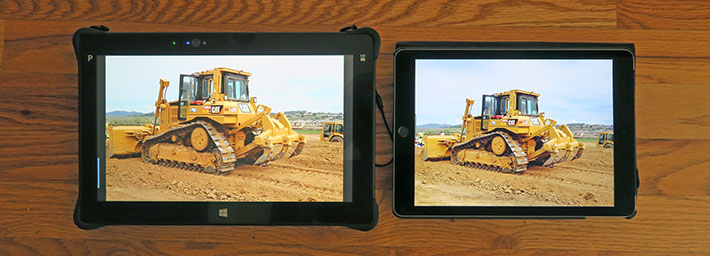
The second setting below shows the two tablets outdoors on a bright August early afternoon, away from direct sunlight. This image shows two things. First, that the T1600 is a match for the iPad Air, which is generally considered the standard of excellence in tablets. Second, and it's not very noticeable in this picture, but the iPad Air 2's reflections are harsher than the significantly more muted ones on the surface of the T1600.
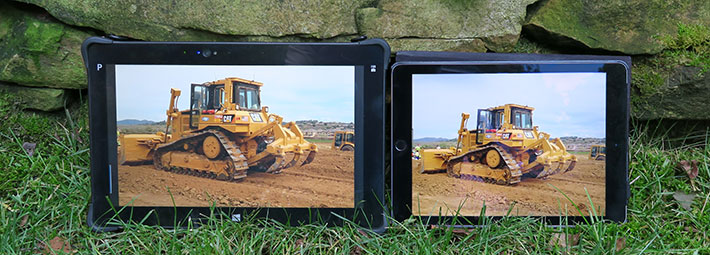
Overall, like most tablets with glossy multi-touch displays, the T1600 has some reflection issues in high-contrast environments. On the plus side, it is very bright, has very good contrast, and remains viewable from any angle, without the dreaded color shifting of lesser displays. There is a slight degradation in brightness when the screen is viewed from extreme angles, likely the result of the slight anti-glare component of the display surface, but not to an extent where it becomes an issue.
Capacitive multi-touch
What was once almost unthinkable is now commonplace: the use of capacitive multi-touch in vertical market handhelds and tablets. That's because a new generation of users expects the effortless tapping, panning, pinching and zooming they're used to from their smartphones and consumer tablets also on the computing tools they use at work. And they will find just that on the xTablet T1600.
Microsoft Windows Tablet PCs, of course, were originally designed to work best with an active pen that enabled "hovering" over selections, with the digitizer sensing the tip of the pen without the user actually touching the surface. And legacy Windows (i.e. Windows 7 and even the desktops in Windows 8, 8.1 and 10) still has all those small interface elements designed for use with a mouse, and not with a finger. It's much better with Windows 10, but even there doing everything with finger taps take some getting used to.
Note that Windows' size issues with capacitive touch can, in part, be addressed by optimizing the legacy Windows user interface in Windows 7 (see RuggedPCReview's how-to) or in Windows 8.1 and later via the Registry Editor (see here). Making the check boxes, scrollers, etc., larger can go a long way in making the OS easier to use with capacitive touch.

Note that a primary reason why Windows-based tablets didn't adopt capacitive touch sooner is because the technology initially didn't work while wearing gloves or when the display got wet. By now, however, capacitive touch technology has advanced to a point where it can be made to work with gloves up to a certain thickness, and they can also work better in the rain. In our testing, we tried using the xTablet T1600 with gloves and it actually works, but only with thin gloves. And the oleophobic coating of MobileDemand's screen protector does help when rain gets on the display surface, though only to a certain point.
Finally, note that MobileDemand offers an optional active digitizer with what looks like a Wacom-technology pen. This is a good option to have for anyone who needs more precision than is available via just finger touch.
Wireless
Strong wireless communications capabilities are a must-have in all tablets, and especially in those used on the job and in the field. The xTablet T1600 is well equipped in that area with dual-band 802.11a/b/g/n WiFi, Class 1 Bluetooth v.4.0, u-Blox Neo-6Q GPS, and optional 4G LTE mobile broadband. The latter can be added via a user-accessible micro-PCIe module in a compartment. The tablet's SIM card slot is located in the externally accessible I/O block. HF (High Frequency) RFID that supports the ISO 15693, 14443A/B standards, as well as NVC ISO 18092 is optionally available for the T1600.
Docks, mounts, accessories
Whenever someone buys a consumer tablet or smartphone, the first thing they usually do is buy a mass-produced protective case for it. The logic of making super-slender fragile electronics, bragging about how thin they are, while knowing full well that all that glitzy beauty must then quickly be hidden in a sturdy enclosure for everyday use is, frankly, beyond reasonable explanation. Fortunately, the rugged computing industry not only makes products that don't break, they also make sure that suitable, custom-designed, high-quality and often indispensable accessories are readily available.
To that extent, MobileDemand offers two optional docking stations, and for office use and one for mounting in vehicles, that provide not only additional USB 2.0 and 3.0 ports, but also HDMI, RJ45 LAN and RS232 serial connectivity. The vehicle dock offers the standard VESA mounting hole pattern compatible with numerous mounting options.
One of the things that has always set MobileDemand apart is that they use their very focussed experience to fix/improve potentially troublesome details. Examples are the locking mechanism of their vehicle dock. They found that some vehicle docks lock the device without a key, which means it could then not be released unless the user had taken the key along. So they changed the mechanism that it positively requires a key to lock the tablet. They also added cable strain relief holes in the backplate, and a keyboard mounting plate. Yes, details matter.

Since many users like to use a handstrap wit their tablet and the T1600 is pretty large for a tablet, MobileDemand improved the pad, straps and metal clips for longer and more comfortable usage. They also added a stylus loop so that the pen isn't just dangling. Again, it's all in the details.
Cameras
The xTablet T1600 has two integrated cameras. The user-facing 2mp camera is for video conferencing, whereas the rear-facing 5mp camera with LED flash can be used for documentation purposes.
Cameras integrated into handheld and tablet computers have historically underperformed compared to even low-end dedicated cameras and, more recently, the cameras available in virtually every smartphone. Things have gotten better on the built-in camera front, but usually not enough to eliminate the need of taking along a dedicated camera or smartphone if photo or video documentation is needed on the job. This remains a concern given that the cameras in leading smartphones are now capable of excellent picture and video quality.
As is, it isn't easy to judge the documentation camera in the T1600. That's because neither the Windows camera app nor the included dedicated app worked very well with the camera. We strongly suspect that the actual imaging hardware is capable of much more, but needs updated or custom camera software to make it work as it should.
In our testing, we used the Windows app which defaulted to 1920 x 1080 pixel both in still and video imaging. In still photography, auto-focus is slow, but once it latches on, images are reasonably sharp, and the camera does not over-compress images. Video was mostly sharp and did not lag behind. Both camera apps, though, only offers very basic functionality, and system integrators and most customers will likely want better software.
Below are pictures shot with the T1600 camera in 1920 x 1080 pixel resolution:

To see a full-size image, click on the picture.
Ruggedness
MobileDemand management's goal has long been for the world to consider their company name as synonymous with "rugged Tablet PC." The xTablet T1600 being ultra-thin and very light, can it still offer all the ruggedness and sealing customers expect from a fully rugged device? According to its official ruggedness specs, the T1600 certainly looks impressive.
For drops, MobileDemand generally conducts its testing in a manner that makes more real-world sense than the procedures described in MIL-STD-810G, Method 516.6, Procedure IV. The MIL-STD, for example, allows testing to be divided among up to five samples, and the units do not have to be on. Out there in the field, users don't bring along four spares, and whatever they drop is usually powered on.
So MobileDemand did 26 drops to the same and powered on unit onto plywood over concrete. The drop is from 36 inches and not the 48 inches the MIL-STD likes because when you drop a unit while standing it's from roughly four feet. We are, however, with MobileDemand on this one.
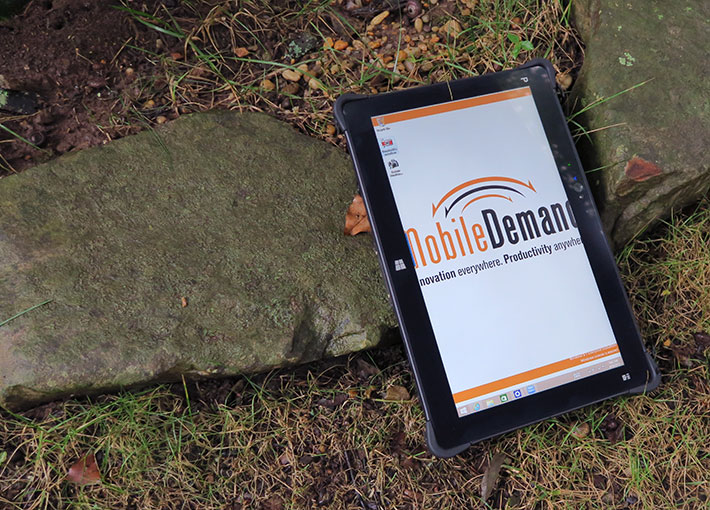
The operating temperature range is given as 14 to 131 degrees Fahrenheit (-10 to 55 centigrade). That is narrower than that of the company's ultra-rugged models, but it's good enough for most operating environments, including commercial freezers, although there are places on earth where it gets hotter and colder than that.
The T1600 is said to withstand shock and vibration resistance in testing similar to MIL-STD-810G, Method 514.6, Procedure I, Category 24, Fig 514.6E-1 which vibrates the unit while it is powered on at prescribed frequencies for an hour per axis. This test does not simulate an actual application environment, but rather suggests that a device that can pass that test will survive in the field.
For sealing against the elements, MobileDemand claims IP65-level ingress protection. The "6" means complete protection against dust, and the "5" means protection against low pressure water jets from all directions. In essence, the xTablet T1600 can handle any degree of rain, but it shouldn't be hosed down with a pressure washer or submerged into water. And keep in mind that the port cover must be firmly in place and all seals must be undamaged in order to provide that protection.
And also keep in mind that some parts of the tablet are technically outside the sealed areas (like the fan and antennae), so liquids can get in there. Which means that after heavy exposure those areas should be examined and dried out.
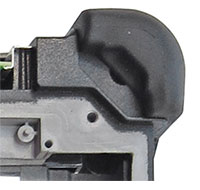 But what about the T1600's large glass surface? We're told it's chemically hardened to a surface hardness of 7H, which is harder than regular window glass or a knife blade (those are about 5.5H), harder than pumice (6) and harder even than a steel file (6.5H). But what about the T1600's large glass surface? We're told it's chemically hardened to a surface hardness of 7H, which is harder than regular window glass or a knife blade (those are about 5.5H), harder than pumice (6) and harder even than a steel file (6.5H).
On top of that, the xTablet T1600 uses a screen protector similar to the one the company applies to its Flex 10 and T1400 tablets. It offers extra protection, and also an oleophobic coating that improves touch performance in rain.
Apart from the printed specs, our in-depth examination of the xTablet T1600 revealed a remarkably sturdy design and construction, especially for such a slender tablet design. A strong magnesium chassis keeps the unit from flexing, guarding against display breakage. Additional protection is provided by the low-tech but very effective and easily replaceable corner rubber bumpers.
Bottom line: MobileDemand xTablet T1600
Overall, the MobileDemand xTablet T1600 is an impressive product. The design is modern, sleek and elegant, but it's also rugged enough for serious outdoor work. The display and technology are suitable even for Windows power users. This is a product many have been waiting 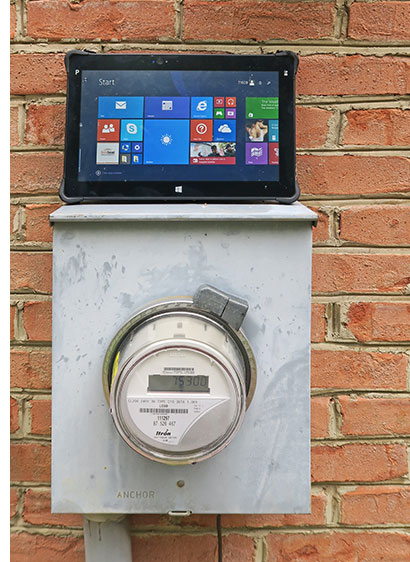 for — a Windows tablet that competently and reliably elevates the state-of-the-art tablet experience into the enterprise and into the field. for — a Windows tablet that competently and reliably elevates the state-of-the-art tablet experience into the enterprise and into the field.
Based on a frugal but powerful Intel "Haswell" Core i5-4200U processor, the xTablet T1600 is a very good performer, aided by its very quick solid state disk. The slender profile of the tablet only allows for a relatively small battery 45.8 watt-hours, but that should be enough for almost a full 8-hour shift.
The T1600 has a satisfyingly large 11.6-inch display with 1366 x 768 pixel wide-format resolution that remains usable outdoors. The capacitive multi-touch screen is very responsive and even works with thin gloves. An active pen option is for those who like to draw or annotate, or need extra precision.
Given its sleek, lightweight design, the xTablet T1600 doesn't look like a rugged tablet. But it is, and remarkably so, thanks to its strong magnesium chassis, solid design, and nicely integrated corner bumpers. IP65 ingress protection means the tablet is dustproof and can easily handle any amount of rain.
Where does the T1600 fit into MobileDemand's product lineup, especially now that the company's two "Flex" models provide rugged Windows tablet functionality at a super-competitive price? MobileDemand explains that users with higher sealing and ruggedness requirements than what the entry-level Flex models offer will look at the ultra-rugged T1200 and T7200 tablets. If it's higher performance and storage capacity acustomer needs, they would first look at the company's xTablet T1400. If they need much higher performance and a bigger screen, that's what the T1600 is for.
Overall, the elegant xTablet T1600 brings Intel Core processor performance and full Windows functionality to those who seek a state-of-the-art tablet that won't weigh them down, and won't break out there in the field, even under extreme conditions. -- Conrad H. Blickenstorfer, August 2015
MobileDemand xTablet T1600 Specs:
| Type |
Thin-and-light rugged Tablet PC
|
| Added |
Added 11/2014, full review 08/2015
|
| Processor |
Intel "Haswell" Core i5-4200U
|
| Processor speed |
1.6GHz (2.60GHz turbo)
|
| CPU Thermal Design Power |
15 watts |
| Chipset |
"Lynx Point" Mobile Intel 8-Series |
| Graphics Chipset |
Intel HD Graphics 4400 |
| OS |
Windows 10 Professional, Windows 8.1 Professional (64-bit), Windows 7 Professional (32-bit or 64-bit) |
| Memory |
4GB or 8GB DDR3L in one socket |
| Display |
TFT LCD with 400 nits LED backlight, optional sunlight-readable 700 nits LCD with optical bonding |
| Display size/res |
11.6" HD (1366 x 768 pixel) |
| Digitizer |
10-point projected capacitive touch (handles rain drops and thin gloves), optional digitizer pen |
| Keyboard |
Onscreen keyboard + optional external |
| Storage |
64GB or 128GB M2-SATA SSD |
| Expansion slots |
1 x microSDHC/SDXC, 1 x SIM card, optional MSR/Smart Card reader |
| Housing |
Plastic with rubber bumpers over magnesium chassis |
| Size |
11.8 x 7.6 x 0.79 inches (299 x 192 x 20 mm) |
| Weight |
2.7 lbs. (1.23 kg) in base configuration |
| Operating temperature |
14° to +131°F (-10° to +55°C) |
| Ingress protection |
IP65
|
| Drop/shock |
26 repeated drops to same operating unit onto plywood over concrete from 36 inches |
| Certifications |
FCC Class B , FCC/SAR, cUS, CE, CB, TUV, UL, NOM |
| Power |
Replaceable 11.1V 4,130mAH 45.8 watt-hour Li-Ion ("7 hrs"); optional: high-capacity 10.6V 10,600mAH 78.4 watt-hour Li-Polymer battery |
| Cameras |
2.0mp front-facing, 5mp rear-facing auto-focus with LED flash and geo-tagging, both support full 1080p video @ 30 fps |
| Sensors |
Ambient light, G-sensor, gyroscope, e-compass |
| Interface |
2 x USB 3.0, audio in/out, dock (power, RS232, USB, HDMI), expansion connector, 2 x external RF antenna connectors |
| Wireless options |
Intel Wireless AC7260 802.11 a/b/g/n/AC WiFi with Class 1 Bluetooth v4.0; optional: GPS, 4G LTE WWAN, NFC/RFID reader, 1D/2D scanner, Mag Stripe Reader
|
| Price |
Inquire |
| Warranty |
TBD
|
| Web |
xTablet T1600 web page |
| Manual |
 xTablet T1600 user manual xTablet T1600 user manual |
| Brochure |
 xTablet T1600 PDF spec sheet xTablet T1600 PDF spec sheet |
| Contact |
MobileDemand
1501 Boyson Square Drive, Suite 101
Hiawatha, IA 52233
Phone: 319.363.4121
Fax: 319.363.4122
|
(copyright 2015 RuggedPCReview.com)
|




